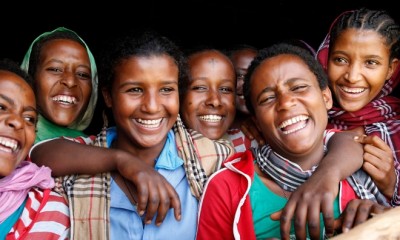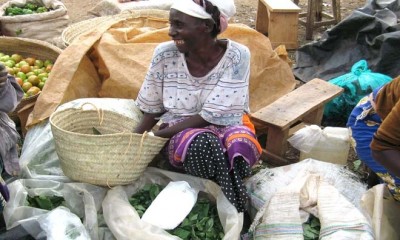Press Release
The 2009 Outlook covers 47 African countries, up from 35 last year. The report finds the region gravely affected by the global economic downturn. Following half a decade of above 5 per cent economic growth, the continent can expect only 2.8 per cent in 2009, less than half of the 5.7 per cent expected before the crisis. The AEO’s authors anticipate growth rebounding to 4.5 per cent in 2010. Growth in oil-exporting countries is expected to fall to 2.4 per cent in 2009 compared to 3.3 per cent for the net oil importers.
The collapse of commodity prices and plummeting demand from OECD countries will have an adverse effect on Africa’s budget balances, with the regional budget deficit for 2009 predicted to be around 5.5 per cent of GDP compared to a surplus of 3.4 predicted in the AEO one year ago. Foreign direct investment decreased by about 10 per cent in 2008. The 2009 AEO also finds that while official development assistance (ODA) increased in 2008, there are concerns over downward pressure on donor aid budgets due to the ongoing economic crisis.
For most of the 1970s and 1980s, growth in Africa was largely constrained by internal factors. Decades of reform addressed most of the internal factors. Combined with a favourable external environment, Africa enjoyed half a decade of growth rates above 5%. The financial crisis has now become an economic crisis; it has eroded benefits accumulated over the years of reform. With a projected growth rate of only 2.8%, and a bias on the downside, many people will fall back into poverty. This is a setback beyond the control of Africans and is likely to be protracted. Using an updated methodology, the Outlook reports that only a handful of African countries are on track to meet the target of halving the share of the population living on less than one dollar a day by 2015.
“However, we should not despair,” says Louis Kasekende, Chief Economist of the AfDB, “the decade of reform has introduced efficiency in macroeconomic management and made African economies more competitive. Countries should therefore desist from implementing policies that restrain further integration of the continent into the global trading and financial environment.”
On a positive note, the 2009 AEO notes that Africa is better positioned to weather the crisis than it was ten years ago. Many countries have undergone prudent macroeconomic reforms in the past few years which have strengthened fiscal balances and reduced inflation to single-digit levels. Many have also benefited from substantial debt relief, with the result that debt service/export ratios are low in most countries.
Javier Santiso, Director and Chief Development Economist of the OECD Development Centre notes that “Asian and Latin American emerging markets have become increasingly important trade and development partners, which also reduces the continent’s vulnerability to the economic performance of OECD countries.”
The 2009 AEO has a special focus on innovations in information and communication technologies (ICTs). It concludes that despite low penetration rates for new technologies, innovative applications of ICT have been proliferating to areas such as e-banking, e-payments, e-agriculture, e-trade, e-government and e-education. Many of these new tools are helping to shape an improved business environment by contributing to market development, overcoming traditional infrastructure constraints and reducing business costs.
“These enterprising uses of ICT show that African countries can pursue growth based on greater domestic investment and consumption, in turn reducing the impact of exogenous shocks and crises,” adds Santiso.
The annual AEO is published jointly by the African Development Bank (AfDB), the OECD Development Centre and the United Nations Economic Commission for Africa, with support from the European Commission.
Regional Overviews
Economic growth in Southern Africa registered at 5.2 per cent in 2008, down from 7 per cent in 2007. It is expected to slow dramatically in 2009 to 0.2 per cent before recovering to 4.6 per cent in 2010. In South Africa, growth is expected to fall to 1.1 per cent due to the impact of the global economic crisis on demand for its mineral exports compounded by a contraction in private consumption and investment. In Angola, the economy is expected to contract by 7.2 per cent in 2009 on the assumption that the reduction in quotas by OPEC countries will translate into a reduction of oil production. In 2008, Madagascar and Malawi benefited from strong growth in agriculture, and large investments in the mineral sector in the former.
Average GDP growth in North Africa is expected to improve slightly from 5.3 per cent in 2007 to 5.8 per cent in 2008. It is then expected to slow significantly in 2009, to 3.3 per cent before increasing to 4.1 per cent in 2010. All North African countries will grow more slowly in 2009, due to cutbacks in oil production and tourism receipts. Morocco and Tunisia have more diversified production and exports that make these countries less vulnerable to the reduction in demand resulting from the crisis, but growth will slow there as well.
Real GDP growth in West African countries is projected to slow to 4.2 per cent in 2009, from 5.4 per cent in 2008 and 2007, before strengthening to 4.6 per cent in 2010. Projections for 2009 indicate a slowdown in Nigeria’s growth rate to 4 per cent, as a result of the OPEC quota on oil production and declining investment. Most of the other countries in the region are also expected to experience slower growth in public and private investment associated with lower commodity prices and remittances. Liberia and Sierra Leone, however, are expected to continue to enjoy high growth rates as output recovers after years of conflict.
In 2008, average GDP growth in the seven countries of Central Africa registered at 5 per cent, up from 4 per cent in 2007. In 2009, GDP growth is expected to slow sharply to 2.8 per cent and increase to 3.6 per cent in 2010. Reduction in demand for oil and minerals will undermine growth in resource-rich countries.
The average growth rate for East Africa is projected at 7.3 per cent in 2008, down from a very strong 8.8 per cent in 2007. The region’s performance is expected to slow to 5.5 per cent in 2009 and remain about the same in 2010. Ethiopia, Rwanda, Sudan, Tanzania, and Uganda – which were the fastest growing economies in East Africa in 2008 — are projected to maintain moderately robust growth in 2009 and 2010 because demand for their major agricultural and horticultural exports is less sensitive to the effects of the crisis. Burundi, The Comoros, and Seychelles are expected to continue stagnating; the latter two experiencing depressed tourism due to the global recession and, in the case of The Comoros, civil unrest. Growth in Djibouti, which registered at 5.9 per cent in 2008, is projected to accelerate in 2009 and 2010 to about 6.6 per cent in this period. Kenya is expected to exhibit strong growth in 2009 (5 per cent) due to the recovery of domestic demand following the sharp slowdown in 2008.
Journalists can consult the report on this site:
Media Enquiries at the OECD Development Centre
Ms. Sala Patterson
Policy Results Officer
Africa and Middle East
Tel: (+33)1 45 24 96 46
E-mail: sala.patterson@oecd.org







